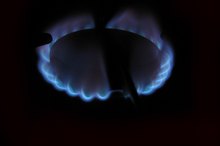What Chemicals Are in Hot & Cold Packs?
Hot and cold packs contain mixtures of chemicals that react together to create heat and cold 1. The chemicals in hot packs combine to cause exothermic reactions, while those in cold packs cause endothermic reactions. The majority of chemicals used in these packs are non-toxic and pose no threat to the environment. The exception is ammonium nitrate, which is not only toxic; it's potentially explosive.
Single Use Hot Packs
The main chemical in single use hot packs is either calcium chloride or magnesium sulfate; the other ingredient is distilled water. Calcium chloride is a common salt that is often used to melt ice from roads and sidewalks. Calcium chloride isn't a food-grade salt, but it isn't toxic. High concentrations of calcium chloride can harm plants and trees near roadways. Magnesium sulfate is another salt compound. It's often used medically for soaking sore muscles and feet--Epsom salt is one example. It's also used as a bath salt and is found in some brands of bottled water.
- The main chemical in single use hot packs is either calcium chloride or magnesium sulfate; the other ingredient is distilled water.
- It's often used medically for soaking sore muscles and feet--Epsom salt is one example.
Single Use Cold Packs
Chemicals Used in a Cold Pack
Learn More
In single use cold packs, the chemical ammonium nitrate is used. Ammonium nitrate is toxic if ingested. It is a very dangerous chemical used in fertilizer and explosives. If a pack breaks open and the ammonium nitrate comes into contact with combustible materials it may explode. Cold packs also contain distilled water and when the inner linings are broken, the ammonium nitrate reacts to the water and causes an exothermic reaction.
- In single use cold packs, the chemical ammonium nitrate is used.
- Cold packs also contain distilled water and when the inner linings are broken, the ammonium nitrate reacts to the water and causes an exothermic reaction.
"Dry" Heat Packs
The chemicals in "dry" hot packs are most often iron powder, activated carbon, vermiculite and salt. They can also contain wood powder and a small amount of water. The chemicals are harmless and most are found in nature. Activated carbon is merely processed charcoal and vermiculite is a natural mineral. These packs begin working after the chemicals are exposed to air.
- The chemicals in "dry" hot packs are most often iron powder, activated carbon, vermiculite and salt.
- These packs begin working after the chemicals are exposed to air.
Related Articles
References
Writer Bio
Beverly Shearer started freelancing in 1996. She has written online for the Daily Sentinel, LIVESTRONG.COM, eHow, Trails Travel and other websites. Beverly has published novels and guidebooks. Currently on educational hiatus, she is studying for a Bachelor of Arts in English with a minor in computer science at Mesa State College.









